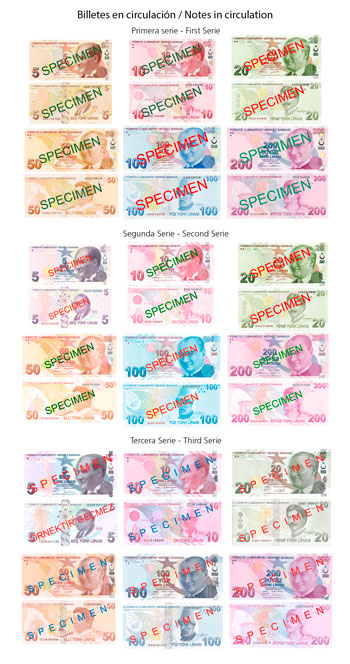Turkish lira exchange rate
WE SELL RATE HISTORY OF TURKISH LIRA
WE BUY RATE HISTORY OF TURKISH LIRA
TURKISH LIRA INFO
The Turkish Lira is the official currency of Turkey. It is also legal tender in North Cyprus.
Notes: 5, 10, 20, 50, 100, 200 lira
Coins: 1, 5, 10, 25, 50 Kuruş and 1 lira
Subunit: Kuruş
Code: TRY
Symbol: ₺
Main Exchanges
If you are going to visit Istambul or any other city of Turkey you will need to exchange your Euros to Turkish Lira. In Eurochange you can buy your Turkish Lira at the best price and with total availability. Buy them now online or find the nearest exchange office with the service to buy currencies.
About the Turkish Lira
The Turkish Lira is the official currency of Turkey and the Turkish Republic of Northern Cyprus. Its ISO 4217 code is TRY and its TL symbol. Each Lira is divided into 100 kuruş.
History of the currency of Turkey
In 1844 the Lira was introduced for the first time in Turkey. Until then the official currency had been the kuruş and, with the arrival of the Lira, it became a fraction of it. Due to high inflation, in 2005, six zeros were eliminated from the Liras and the New Liras began to be issued, which are the ones we know today.
Turkish Lira banknotes and coins
At present three series of Turkish Liras coexist and the three belong to the issue group 9. The designs of the notes of the three series are the same, but the colours of the notes change slightly in each one.
Turkish Lira notes are 5, 10, 20, 50, 100 and 200 Liras. On the obverse of the banknotes, the image of Mustafa Kemal Atatürk (founder and first president of the Republic of Turkey between 1923 and 1938) appears and on the reverse appear different relevant characters of Turkish history, science and culture.
BANKNOTES OF TURKISH LIRA IN CIRCULATION
In the 5 Lira notes appears Aydın Sayılı, a leading Turkish scientist who studied the history of science. He obtained a Master's degree in History of Science at Harvard and obtained the first Harvard Ph.D. in the subject. Throughout his life he was awarded several times for his work and research.
On the 10 Liras note appears Cahit Arf. Cahit was a Turkish scientist and mathematician. He obtained his doctorate at the University of Göttingen and received great recognition for his work in algebra.
On the 20 Liras note appears Mimar Kemaleddin. Mimar was a Turkish architect who studied in Berlin. As a result he created a new architectural style that mixed features of German architecture with classical Ottoman architecture.
On the 50 Liras note, Fatma Aliye appears. Fatma was the first Turkish philosopher and one of the first female novelists in the country. It also promoted the struggle for women's rights, for their education and for their participation in the country's industry.
On the 100 Liras note appears Buhurizade Mustafa Efendi, also known as "Itri". He is considered the founder of Turkish classical music. He introduced religious music in Turkey, which meant the arrival of a new form of music.
On the 200 Liras note, Yunus Emre appears. Yunus is one of the first representatives of mysticism and mystical poetry. He studied Greek and Iranian mythology, as well as the Koran. It promoted among the citizens mystical concepts with a beautiful and simple language.
The coins in Turkish Lira are minted by the Turkish Mint and Stamp. They are 1, 5, 10, 25 and 50 kuruş and 1 Lira. On the head of the coins appears the image of Mustafa Kemal Atatürk, just as on the notes. On the tail appear a crescent moon and a star (symbols of Islam), some tulips and the Bosphorus Bridge.
How many Turkish Liras do I need to go to Turkey?
If you are preparing your trip to Turkey and do not know how many Turkish Liras you will need, we can help you. Our clients usually exchange around 470 Euros in Turkish Liras. In order to make an approximate calculation of the amount you need to take on your trip, you should take into account what kind of expenses you will have once you arrive at your destination. It is possible that when you arrive, you will have to pay for hotels, excursions, entrance fees or rental cars, or you may simply have expenses such as food, public transport or shopping.
Look for the closest office with this currency



